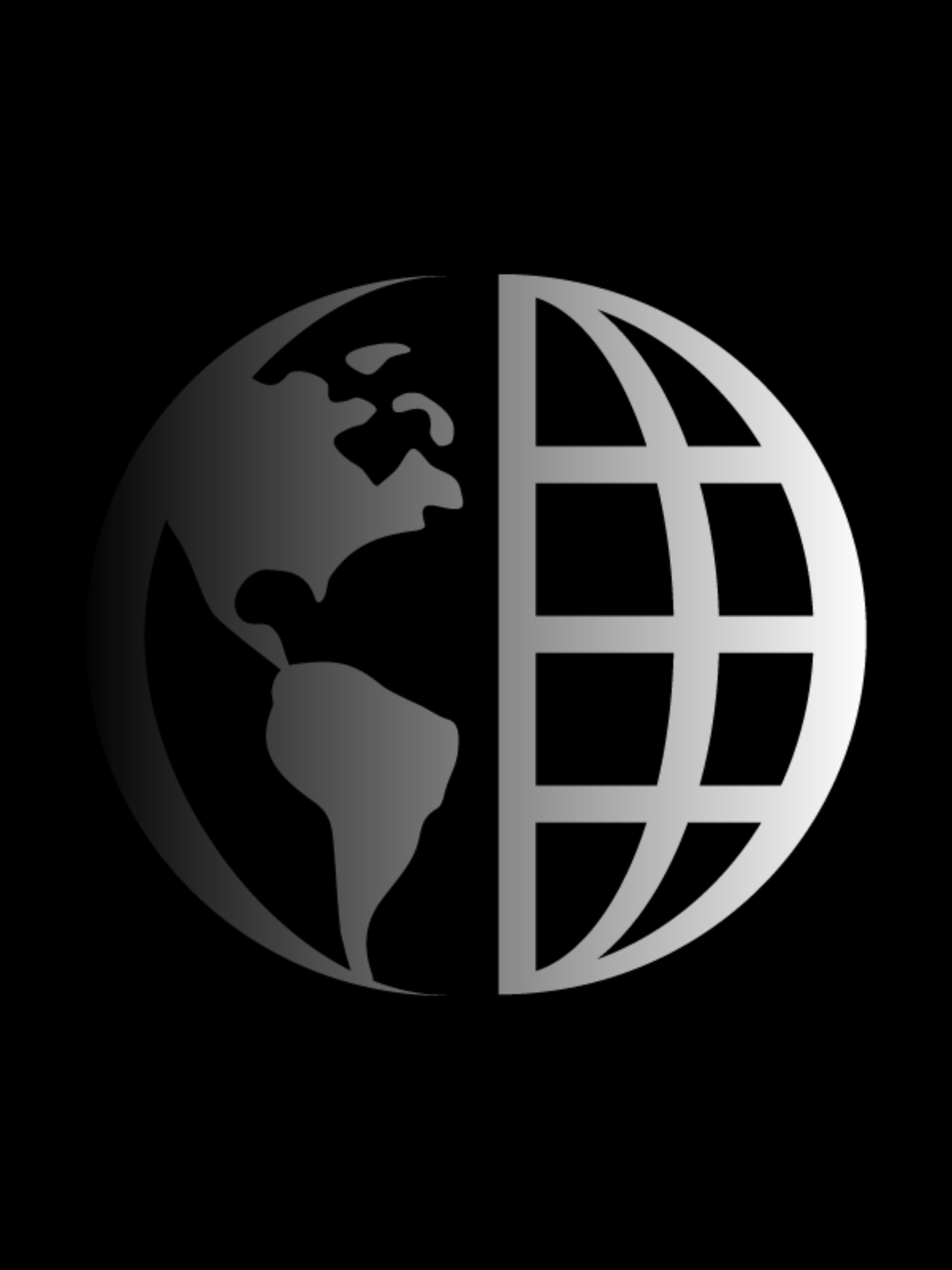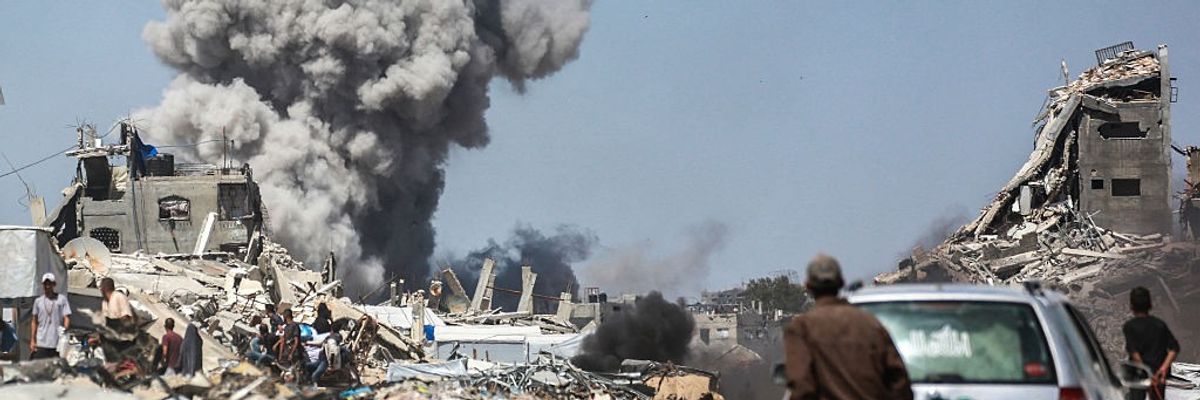

SUBSCRIBE TO OUR FREE NEWSLETTER
Daily news & progressive opinion—funded by the people, not the corporations—delivered straight to your inbox.
5
#000000
#FFFFFF
To donate by check, phone, or other method, see our More Ways to Give page.


Daily news & progressive opinion—funded by the people, not the corporations—delivered straight to your inbox.

People watch as smoke billows following an Israeli strike in Jabalia, Gaza on May 25, 2025.
"These are not isolated accounts; they point to a systemic failure and a horrifying moral collapse," said the executive director of Breaking the Silence.
Israeli soldiers have "systematically" used Palestinians as human shields during the 19-month assault on the Gaza Strip, The Associated Press reported Saturday, citing Palestinian civilians and members of the Israel Defense Forces who described engaging in the practice that is banned under international humanitarian law.
"Orders often came from the top, and at times nearly every platoon used a Palestinian to clear locations," AP reported, citing the account of an unnamed Israeli officer.
One Palestinian man, Ayman Abu Hamadan, said Israeli soldiers dressed him in army fatigues, attached a camera to his forehead, and forced him to enter homes to ensure they were clear of bombs and militants. Abu Hamadan said he was passed from unit to unit for over two weeks.
"Soldiers stood behind him and, once it was clear, entered the buildings to damage or destroy them, he said," AP reported. "He spent each night bound in a dark room, only to wake up and do it again."
Nadav Weiman, executive director of Breaking the Silence—an anti-occupation group founded by former Israeli soldiers—told AP that "these are not isolated accounts; they point to a systemic failure and a horrifying moral collapse."
Israeli officials frequently justify attacks on homes, hospitals, and other civilian infrastructure by alleging that Hamas uses Gaza's civilian population as human shields. But Israeli forces have long been accused of using detained Palestinians as human shields, both during and prior to the current assault on Gaza.
According to the Israeli human rights organization B'Tselem, "Over the years, the military practiced an official policy of using Palestinians as human shields, ordering them to carry out military activities that put their lives in jeopardy: Palestinians were forced to remove suspicious objects from roads, tell other Palestinians to come out and surrender themselves, physically shield soldiers while they fired, and more."
"In most cases, no one was held accountable," the group said.
Earlier this year, an anonymous Israeli officer wrote in a column for Haaretz that "in Gaza, human shields are used by Israeli soldiers at least six times a day."
"Today, almost every platoon keeps a 'shawish,' and no infantry force enters a house before a 'shawish' clears it," the officer wrote. "This means there are four 'shawishes' in a company, twelve in a battalion, and at least 36 in a brigade. We operate a sub-army of slaves."
In response to AP's reporting, the IDF told the Jerusalem Post that it would only investigate the claims in the story "if further details are provided."
The reporting came as Israel continued with its large-scale ground offensive and aerial assault in Gaza, where the entire population is facing a dire hunger crisis due to Israel's monthslong siege.
On Sunday, according to Reuters, "Israeli military strikes killed at least 23 Palestinians across the Gaza Strip... including a local journalist and a senior rescue service official."
Hours earlier, an Israeli strike on a home in Khan Younis killed nine children of a Nasser Hospital pediatrician and badly injured her husband while she was at work.
"Targeting families in the still-standing buildings: distinguishable sadistic pattern of the new phase of the genocide," Francesca Albanese, the United Nations special rapporteur on the occupied Palestinian territories, wrote in response to the deadly strike.
Dear Common Dreams reader, The U.S. is on a fast track to authoritarianism like nothing I've ever seen. Meanwhile, corporate news outlets are utterly capitulating to Trump, twisting their coverage to avoid drawing his ire while lining up to stuff cash in his pockets. That's why I believe that Common Dreams is doing the best and most consequential reporting that we've ever done. Our small but mighty team is a progressive reporting powerhouse, covering the news every day that the corporate media never will. Our mission has always been simple: To inform. To inspire. And to ignite change for the common good. Now here's the key piece that I want all our readers to understand: None of this would be possible without your financial support. That's not just some fundraising cliche. It's the absolute and literal truth. We don't accept corporate advertising and never will. We don't have a paywall because we don't think people should be blocked from critical news based on their ability to pay. Everything we do is funded by the donations of readers like you. Will you donate now to help power the nonprofit, independent reporting of Common Dreams? Thank you for being a vital member of our community. Together, we can keep independent journalism alive when it’s needed most. - Craig Brown, Co-founder |
Israeli soldiers have "systematically" used Palestinians as human shields during the 19-month assault on the Gaza Strip, The Associated Press reported Saturday, citing Palestinian civilians and members of the Israel Defense Forces who described engaging in the practice that is banned under international humanitarian law.
"Orders often came from the top, and at times nearly every platoon used a Palestinian to clear locations," AP reported, citing the account of an unnamed Israeli officer.
One Palestinian man, Ayman Abu Hamadan, said Israeli soldiers dressed him in army fatigues, attached a camera to his forehead, and forced him to enter homes to ensure they were clear of bombs and militants. Abu Hamadan said he was passed from unit to unit for over two weeks.
"Soldiers stood behind him and, once it was clear, entered the buildings to damage or destroy them, he said," AP reported. "He spent each night bound in a dark room, only to wake up and do it again."
Nadav Weiman, executive director of Breaking the Silence—an anti-occupation group founded by former Israeli soldiers—told AP that "these are not isolated accounts; they point to a systemic failure and a horrifying moral collapse."
Israeli officials frequently justify attacks on homes, hospitals, and other civilian infrastructure by alleging that Hamas uses Gaza's civilian population as human shields. But Israeli forces have long been accused of using detained Palestinians as human shields, both during and prior to the current assault on Gaza.
According to the Israeli human rights organization B'Tselem, "Over the years, the military practiced an official policy of using Palestinians as human shields, ordering them to carry out military activities that put their lives in jeopardy: Palestinians were forced to remove suspicious objects from roads, tell other Palestinians to come out and surrender themselves, physically shield soldiers while they fired, and more."
"In most cases, no one was held accountable," the group said.
Earlier this year, an anonymous Israeli officer wrote in a column for Haaretz that "in Gaza, human shields are used by Israeli soldiers at least six times a day."
"Today, almost every platoon keeps a 'shawish,' and no infantry force enters a house before a 'shawish' clears it," the officer wrote. "This means there are four 'shawishes' in a company, twelve in a battalion, and at least 36 in a brigade. We operate a sub-army of slaves."
In response to AP's reporting, the IDF told the Jerusalem Post that it would only investigate the claims in the story "if further details are provided."
The reporting came as Israel continued with its large-scale ground offensive and aerial assault in Gaza, where the entire population is facing a dire hunger crisis due to Israel's monthslong siege.
On Sunday, according to Reuters, "Israeli military strikes killed at least 23 Palestinians across the Gaza Strip... including a local journalist and a senior rescue service official."
Hours earlier, an Israeli strike on a home in Khan Younis killed nine children of a Nasser Hospital pediatrician and badly injured her husband while she was at work.
"Targeting families in the still-standing buildings: distinguishable sadistic pattern of the new phase of the genocide," Francesca Albanese, the United Nations special rapporteur on the occupied Palestinian territories, wrote in response to the deadly strike.
Israeli soldiers have "systematically" used Palestinians as human shields during the 19-month assault on the Gaza Strip, The Associated Press reported Saturday, citing Palestinian civilians and members of the Israel Defense Forces who described engaging in the practice that is banned under international humanitarian law.
"Orders often came from the top, and at times nearly every platoon used a Palestinian to clear locations," AP reported, citing the account of an unnamed Israeli officer.
One Palestinian man, Ayman Abu Hamadan, said Israeli soldiers dressed him in army fatigues, attached a camera to his forehead, and forced him to enter homes to ensure they were clear of bombs and militants. Abu Hamadan said he was passed from unit to unit for over two weeks.
"Soldiers stood behind him and, once it was clear, entered the buildings to damage or destroy them, he said," AP reported. "He spent each night bound in a dark room, only to wake up and do it again."
Nadav Weiman, executive director of Breaking the Silence—an anti-occupation group founded by former Israeli soldiers—told AP that "these are not isolated accounts; they point to a systemic failure and a horrifying moral collapse."
Israeli officials frequently justify attacks on homes, hospitals, and other civilian infrastructure by alleging that Hamas uses Gaza's civilian population as human shields. But Israeli forces have long been accused of using detained Palestinians as human shields, both during and prior to the current assault on Gaza.
According to the Israeli human rights organization B'Tselem, "Over the years, the military practiced an official policy of using Palestinians as human shields, ordering them to carry out military activities that put their lives in jeopardy: Palestinians were forced to remove suspicious objects from roads, tell other Palestinians to come out and surrender themselves, physically shield soldiers while they fired, and more."
"In most cases, no one was held accountable," the group said.
Earlier this year, an anonymous Israeli officer wrote in a column for Haaretz that "in Gaza, human shields are used by Israeli soldiers at least six times a day."
"Today, almost every platoon keeps a 'shawish,' and no infantry force enters a house before a 'shawish' clears it," the officer wrote. "This means there are four 'shawishes' in a company, twelve in a battalion, and at least 36 in a brigade. We operate a sub-army of slaves."
In response to AP's reporting, the IDF told the Jerusalem Post that it would only investigate the claims in the story "if further details are provided."
The reporting came as Israel continued with its large-scale ground offensive and aerial assault in Gaza, where the entire population is facing a dire hunger crisis due to Israel's monthslong siege.
On Sunday, according to Reuters, "Israeli military strikes killed at least 23 Palestinians across the Gaza Strip... including a local journalist and a senior rescue service official."
Hours earlier, an Israeli strike on a home in Khan Younis killed nine children of a Nasser Hospital pediatrician and badly injured her husband while she was at work.
"Targeting families in the still-standing buildings: distinguishable sadistic pattern of the new phase of the genocide," Francesca Albanese, the United Nations special rapporteur on the occupied Palestinian territories, wrote in response to the deadly strike.